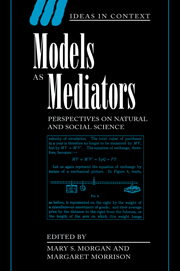Book contents
- Frontmatter
- Contents
- List of contributors
- Preface
- 1 Introduction
- 2 Models as mediating instruments
- 3 Models as autonomous agents
- 4 Built-in justification
- 5 The Ising model, computer simulation, and universal physics
- 6 Techniques of modelling and paper-tools in classical chemistry
- 7 The role of models in the application of scientific theories: epistemological implications
- 8 Knife-edge caricature modelling: the case of Marx's Reproduction Schema
- 9 Models and the limits of theory: quantum Hamiltonians and the BCS models of superconductivity
- 10 Past measurements and future prediction
- 11 Models and stories in hadron physics
- 12 Learning from models
- Index
3 - Models as autonomous agents
Published online by Cambridge University Press: 10 March 2010
- Frontmatter
- Contents
- List of contributors
- Preface
- 1 Introduction
- 2 Models as mediating instruments
- 3 Models as autonomous agents
- 4 Built-in justification
- 5 The Ising model, computer simulation, and universal physics
- 6 Techniques of modelling and paper-tools in classical chemistry
- 7 The role of models in the application of scientific theories: epistemological implications
- 8 Knife-edge caricature modelling: the case of Marx's Reproduction Schema
- 9 Models and the limits of theory: quantum Hamiltonians and the BCS models of superconductivity
- 10 Past measurements and future prediction
- 11 Models and stories in hadron physics
- 12 Learning from models
- Index
Summary
INTRODUCTION
Perhaps the key philosophical question regarding the nature of models concerns their connection to concrete physical systems and the degree to which they enable us to draw conclusions about these systems. This presupposes, of course, that models can sometimes be understood as representative of objects or systems in the world. But how should we understand this presupposition? It seems not quite correct to say that models accurately describe physical systems since in many cases they not only embody an element of idealisation and abstraction, but frequently represent the world in ways that bear no similarity to physically realisable objects, e.g. the electron as a point particle. Hence, we need a reformulation of the philosophical question; more specifically, since models are sometimes deliberately based on characterisations we know to be false how can they provide us with information about the world.
There are different answers to this latter question, each of which depends first, on how one views the nature and role of models and secondly, how one understands the philosophically problematic issue of what it means to accept a model as providing reliable information about real systems, as opposed to simply successful predictions. I will say something about both of these issues and how they relate to each other in what follows but let me begin by mentioning two different and rather surprising characterisations of models given by two different physicists, Dirac, the esteemed theoretician, and Heinrich Hertz, the equally esteemed experimentalist. Each view recognises but deals differently with the epistemological issues that surround the use of models in physics.
- Type
- Chapter
- Information
- Models as MediatorsPerspectives on Natural and Social Science, pp. 38 - 65Publisher: Cambridge University PressPrint publication year: 1999
- 103
- Cited by

